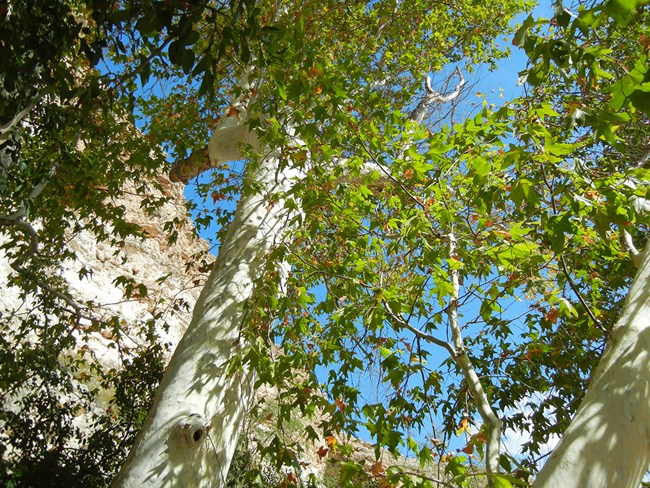
NPS Photo Entangled In NatureThe Arizona Sycamore, also known as Buttonwood, is one of the largest native trees in Arizona today! They are found along creeks and waterways where it has constant access to water usually between 1,000 and 5,000 feet elevation. No one knows how long the Sycamore lives because it does not form annual rings like most other trees. Instead it develops inter-annual rings based on how much water it receives. The large trunks and branches are covered by a thin white bark which is the most noticeable feature. Pieces of bark flake and peel away as the tree grows because the bark is not flexible and ends up splitting apart like a puzzle and falling off. This effect leaves behind a mosaic of pale green, white, and grey patches that look like camouflage. It can also be identified by a giant umbrella of spreading branches creating a broad, open crown with star-shaped leaves. Unseen are the sycamores' roots, which help to slow down soil erosion. The branches and hollows of Arizona Sycamores create a vital nesting area for many species of small mammals and birds.Living MemoryThe Sinagua people had deep community connections that included their families, their neighbors, and the natural world around them. Like the roots of a tree, these connections held their world together, and enabled the people to grow both in their understandings and their relationships with their world. A thousand years ago, the Verde Valley held a vast and complex network of trade relationships, agricultural knowledge, and sustainable land stewardship practices. The ability of these people to support themselves in this arid environment is evidence of their resourcefulness and intimate knowledge of the natural world. This knowledge was carefully honed over the centuries, shared with neighbors and passed down through the generations to ensure that each group of children was as familiar with the land as their ancestors were.For the Sinagua people, each plant, each animal, and each rock in the landscape was deeply familiar. Along the creeks and riverbeds of the Verde Valley, the trees that we now call the Arizona Sycamore were an incredibly valuable resource. These trees were used for construction of structures like Montezuma Castle, where their enormous limbs made strong central beams, and they were - and still are! - an indicator of the presence of springs, perennial streams, and other reliable water sources. The trees pass enormous quantities of water through their leaves in the summer, increasing humidity along waterways and making it easier for other plants, animals, and people to survive. |
Last updated: February 5, 2021
